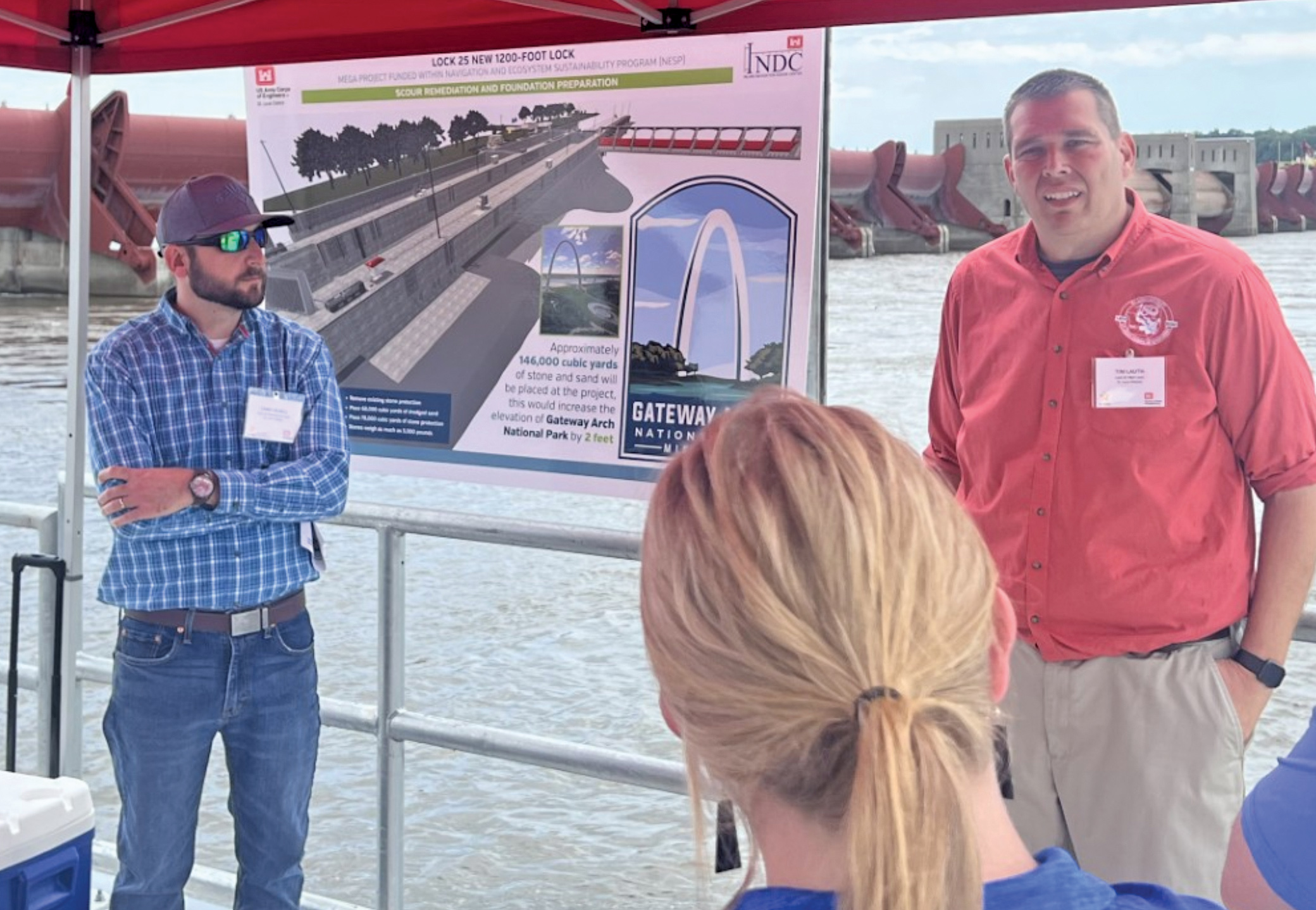Three years after the passage and signing of the Infrastructure Investment and Jobs Act (IIJA), most of its funding is still unspent, and the inland industry “remain[s] frustrated with the pace of inland repairs,” said Spencer Murphy, chair of the Inland Waterways Users Board (IWUB), in his opening remarks at the board’s quarterly meeting August 1 in St. Charles, Mo.
“Transparency remains critical,” said Murphy, who is general counsel and vice president of risk management at Canal Barge Company. “We can’t return to a place where construction takes decades, and we can’t help the Corps [of Engineers] if we are not given accurate information.”
The Inland Waterways Users Board is an advisory board established to monitor the Inland Waterways Trust Fund and to make recommendations to the U.S. Army Corps of Engineers and to Congress on investment priorities using resources from the fund. The Corps of Engineers’ director of civil works, Eddie Belk, serves as the IWUB executive director, while the assistant secretary of the Army for civil works serves as an interagency observer, along with representatives of the Maritime Administration, National Oceanic and Atmospheric Administration (NOAA) and the Department of Agriculture.
Capital Investment Strategy
Michael Tarpey, senior program manager of the Corps’ Navigation Branch, gave an update on the progress of the Capital Investment Strategy (CIS). Section 302(d) of WRDA 1986 requires “coordination with the users board” in developing the CIS.
Draft scenarios of the CIS were developed in March and presented to the IWUB in April, and a draft was completed in June. After incorporation of IWUB comments in August, the strategy will be submitted to the assistant secretary of Army for civil works in September. The goal is to submit the finalized report to Congress in January.
The CIS will cover a timeline of 2025 through 2044 and incorporates the WRDA cost-share change of a 65 percent general fund/35 percent Inland Waterways Trust Fund split. The Senate’s version of this year’s Water Resource Development Act adjusts the cost-share to 75/25, which would give the IWTF the ability to stretch the money in the fund farther. The CIS must, by statute, be updated every five years to reflect current funding and economic assumptions.
CIS projects in active construction include: Monongahela River Locks 2, 3 and 4 in Pennsylvania; the Three Rivers Project in Arkansas; Chickamauga Lock on the Tennessee River near Chattanooga, Tenn.; Kentucky Lock on the Tennessee River in Kentucky; Lock and Dam 25 on the Upper Mississippi River near Winfield, Mo.; and LaGngrange Lock and Dam on the Illinois River near Versailles, Ill.
Projects in active design include Brazos River Floodgates on the Gulf Intracoastal Waterway in Texas, Emsworth Lock on the Ohio River near Pittsburgh and the major rehabilitation of T.J. O’Brien Lock in Chicago.
The CIS goal is to complete all lock constructions in eight years or fewer.
The IWUB presentation team laid out three funding assumptions or scenarios for completing projects: efficient funding, inefficient funding and “enhanced” or 100 percent IIJA funding. Tarpey added that, under current funding assumptions, only two locks at a time can be efficiently funded.
Craig Moulton, inland navigation program manager, reported on outstanding major rehab projects. The T.J. O’Brien Lock and Dam on the Illinois River still needs $32.4 million in future funding, with a projected completion date of 2031. Winfield Lock and Dam’s new 1,200-foot lock is still awaiting construction funds. Two locks and dams on the McClellan-Kerr Arkansas River Navigation System are awaiting evaluation of alternatives, while a third is awaiting funding.
Remote Lock Operation
The recently passed Senate version of WRDA includes an instruction that prohibits the Corps from using any funds for remote lock operations until the Corps completes a national assessment on lock and dam remote operations and develops a stakeholder engagement plan.
The Corps team presenting on remote lock operations at the IWUB meeting laid out four goals. The first goal is consistent national implementation, with the Corps establishing a program to develop policy and guidance to enable consistent implementation across districts. The second goal is to develop common operating procedures, staffing, design and equipment components. Thirdly, the Corps intends to develop a multi-year life cycle investment plan that is flexible and adaptable to unique requirements and circumstances. The fourth goal is to prioritize people and implement a staffing transition and training plan.
A national assessment on lock and dam remote operations was completed last November, but in the phase 2 timeline, it will take more than two years to develop national standards. Controls modernization—updating lock controls to digital—could take up to 10 years for all locks in the system and is a separate undertaking from any possible remote operation. The regional analyses—making the business case for each region—will also be a multi-year process, the Corps team said.
Other Project Reports
IWUB members received a report on Monongahela River Locks and Dam 3 near Elizabeth, Pa. On July 15, officials discovered an issue with the water level in the primary lock chamber. In response, the district implemented a 7-foot draft restriction.
The navigation industry continues to utilize the landside lock chamber within this navigational restriction to preserve navigation and avoid the possibility of damaging vessels or the lock chamber itself.
Although the landside lock remains in service, officials said they recognize the impact the draft restriction is having on industry. To that end, the district is working with its contractor to open a 100-foot navigation channel through the existing fixed-crest dam, thus eliminating the need to use the lock. The original projected timeline for opening the channel to navigation was December, but the Pittsburgh Engineer District announced in late July the expedited date for it opening is August 28.. While construction is ongoing to establish the in-dam channel, industry will have full use of the lock chamber within the 7-foot draft restriction. Once the district has established the channel, commercial traffic will use the channel.
Jose Lopez, the project manager for Lock and Dam 25 in Winfield, Mo., which the IWUB team visited the day before its meeting, reported that the project was “re-benchmarked” in July due to a change in acquisition strategy. The delivery method will now be design, bid and build, and the remaining proceeds from the Bipartisan Infrastructure Law will be used to fund the work in a base-plus-options contract structure, subject to acquisition plan approval. A supplemental National Environmental Policy Act (NEPA) supplemental environmental assessment is under review, and the project is in the 65-percent design review phase. The design work is fully funded, but the construction phase is not. The design review for the new 1,200-foot lock is due to be completed in June 2026. Under an “efficient” funding scenario, the project cost is estimated at $1.5 billion, versus about $2.26 billion in an “inefficient” funding scenario.
One of the project challenges is its “in the wet” construction method, and Lopez said frequent and close collaboration with the contractors is the best way to manage the closures and width restrictions.
Photo caption: Chris Redell (left) and Tim Lauth discuss scour remediation and foundation prep during an Inland Waterways Users Board tour of Lock and Dam 25 near Winfield, Mo., July 31. (Photo courtesy of Waterways Council Inc.)




